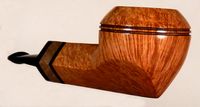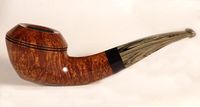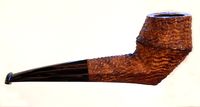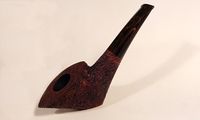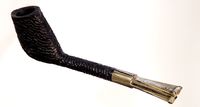Gigliucci pipe: Difference between revisions
No edit summary |
No edit summary |
||
| (5 intermediate revisions by the same user not shown) | |||
| Line 6: | Line 6: | ||
[[File:piet.jpg|200px|thumb|left|In an Etruscan tomb near my house]] | [[File:piet.jpg|200px|thumb|left|In an Etruscan tomb near my house]] | ||
The area I live in (Maremma,south of Tuscany) is very rich in | The area I live in (Maremma,south of Tuscany) is very rich in briar, a wood that I knew long before I started making pipes, and I often also know the areas where the briar is extracted from the ground. This makes it even more exciting to follow this subject in the various phases of seasoning and processing. | ||
In the two sawmills I use (Segherie Maremmane and Manno Briar) I always personally choose each plaque to season it in my lab. | In the two sawmills I use (Segherie Maremmane and Manno Briar) I always personally choose each plaque to season it in my lab. | ||
The mouthpiece, cut only by hand, is only of ebonite bar, preferring the typical comfort of this material. | The mouthpiece, cut only by hand, is only of ebonite bar, preferring the typical comfort of this material. | ||
| Line 13: | Line 13: | ||
Since 2011 I have been able to confront and learn many things from the collaboration with the "Foundation" builders' team of the "Becker & Musicò" Roman store and the attendance of Paolo Becker's workshop, two of the Italian realities where the classical canon and the classic modern (danish), is studied, destructured and reproposed. | Since 2011 I have been able to confront and learn many things from the collaboration with the "Foundation" builders' team of the "Becker & Musicò" Roman store and the attendance of Paolo Becker's workshop, two of the Italian realities where the classical canon and the classic modern (danish), is studied, destructured and reproposed. | ||
I think these are elements that we can find in my work as well as the attention to the general functionality of the pipe: weight, right drilling, balance and quality of materials are essential starting conditions to create a good pipe. | I think these are elements that we can find in my work as well as the attention to the general functionality of the pipe: weight, right drilling, balance and quality of materials are essential starting conditions to create a good pipe. | ||
The study of classic shapes is combined with the research of new lines, creating a personal language. | The study of classic shapes is combined with the research of new lines, creating a personal language. | ||
| Line 18: | Line 19: | ||
The production is about 150 pieces for years, totally handcarved in my workshop in Caldana(GR) Tuscany. | The production is about 150 pieces for years, totally handcarved in my workshop in Caldana(GR) Tuscany. | ||
http://www.gigliuccipipe.com | |||
[[File:bull A.jpg|200px|thumb|left|bulldog]][[File:bull B.jpg|200px|thumb|centre|bent bulldog]][[File:hull C.jpg|200px|thumb|right|hull bulldog]] | |||
[[File:ref D.jpg|200px|thumb|left|904 reformed]][[File:flat E.jpg|200px|thumb|centre|flattened]] | |||
Revision as of 11:37, 20 September 2017
I was born in Follonica, Tuscany, in 1968. I attended the School of Fine Arts in Bologna and at the same time started to move in the Art environment.
My first job was as cabinetmaker and I opened my own restoration workshop in 1999. In 2006 I made my very first briar pipe.
The area I live in (Maremma,south of Tuscany) is very rich in briar, a wood that I knew long before I started making pipes, and I often also know the areas where the briar is extracted from the ground. This makes it even more exciting to follow this subject in the various phases of seasoning and processing. In the two sawmills I use (Segherie Maremmane and Manno Briar) I always personally choose each plaque to season it in my lab. The mouthpiece, cut only by hand, is only of ebonite bar, preferring the typical comfort of this material.
Since 2011 I have been able to confront and learn many things from the collaboration with the "Foundation" builders' team of the "Becker & Musicò" Roman store and the attendance of Paolo Becker's workshop, two of the Italian realities where the classical canon and the classic modern (danish), is studied, destructured and reproposed.
I think these are elements that we can find in my work as well as the attention to the general functionality of the pipe: weight, right drilling, balance and quality of materials are essential starting conditions to create a good pipe.
The study of classic shapes is combined with the research of new lines, creating a personal language.
The production is about 150 pieces for years, totally handcarved in my workshop in Caldana(GR) Tuscany.

